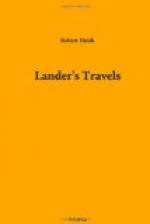Futika, the frontier town of Zeg Zeg, was reached on the second day from Guari; and at Zaria, where the travellers arrived on the fourth, they found themselves in a city almost wholly peopled by Fellatas, who have mosques with minarets, and live in flat-roofed houses. The population is said to exceed that of Kano, and must contain above fifty thousand inhabitants. A great number of the inhabitants are from Foota Ronda and Foota Torra, the Foulahs and Fellatas being, in fact, the same people. The people from the west professed to be well acquainted with both the English and the French, and they rattled over the names of the towns between Sierra Leone and the Senegal and Timbuctoo. They were armed with French fusees, preferring the guns of the French and the powder of the English.
The old city of Zaria was taken by the Fellatas, within a month after they had made themselves masters of the provinces of Goober and Zamfra, about thirty years ago. It took a siege of two days, when it was evacuated by the sultan and the greater part of the inhabitants, who took refuge in hills south and west, where they still maintain their independence, though subject to the continual attacks of the Fellatas. The old city is now known only by its ruined walls, surrounding some high mounds, which were in the centre of the enclosed area. The new city, built by the Fellatas, to the south-east of the old, consists of a number of little villages and detached houses, scattered over an extensive area, surrounded with high clay walls. Near the centre of the wall stands the principal mosque, built of clay, with a minaret nearly fifty feet high. On entering one of the western gates, instead of finding houses, the travellers could but just see the tops of some of them over the growing grain, at about a quarter of a mile distance; all was walled fields full of dhourra, with here and there a horse tethered in the open space.
The province of Zeg Zeg is the most extensive in the kingdom of Houssa, and both Kashna and Kano were at one time tributary to its sovereigns. The name of the country appears to be also given to the capital, and is possibly derived from it. It must, however, be observed that Lander mentions Zaria only by the name of Zeg Zeg. Prior to the Fellata conquest, Islamism is said to have been unknown in Zeg Zeg, and the southern part is still in the possession of various pagan tribes, whose country is called Boushir or Boushi, that is, the infidel country, and is said to extend to the ocean.
The country in the vicinity of the capital, Zaria, is clear of wood, and is all either in pasture or under cultivation. Its appearance at this season resembled some of the finest counties in England at the latter end of April. It was beautifully variegated with hill and dale, like the most romantic parts of England; was covered with luxuriant crops and rich pastures, and produced the best rice grown in any part of that continent. Rows of tall trees, resembling gigantic avenues of poplar, extended from hill to hill. Zaria, like many other African cities, might be considered as a district of country surrounded with walls.




